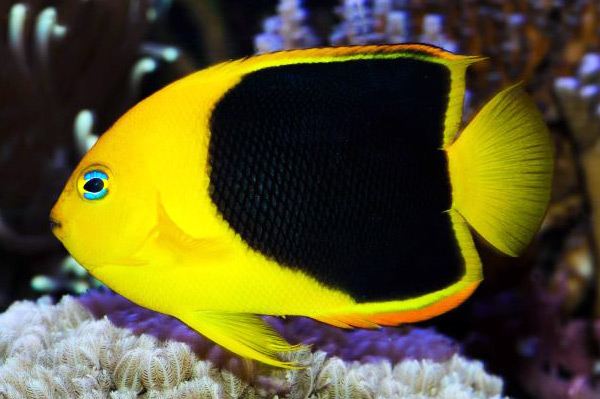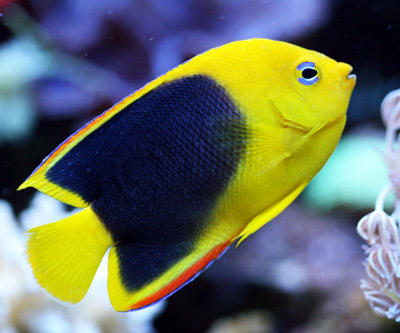On one of my earliest dives down in the Florida Keys back in the 1990s, a gorgeous yellow and black angelfish caught my attention as I drifted over a section of reef. In my mind’s eye, I envision the angel hovering boldly above a large barrel sponge, but I can’t be sure whether that’s actually how it happened or just an idyllic memory. In any case, I was taken with its distinctive appearance and wondered whether it might make a good aquarium candidate.
As anyone familiar with the fauna of the tropical western Atlantic has already guessed, the angel I saw back then was a rock beauty (Holacanthus tricolor)—a species that, unfortunately, tends to fare poorly in marine aquaria and is generally best left to advanced fishkeepers or, better yet, in the ocean where it can beguile other divers. I’ll get into why in just a moment.
Physical traits
H. tricolor is laterally compressed (flattened from side to side) and, in typical angel fashion, sports a sharp, backward curving spine on the gill cover (operculum). As alluded above, this species is yellow on the anterior portion of the body and on the caudal fin and black from behind the gills to the caudal peduncle (base of the tail). The margin of the anal fin, the edge of the operculum, and the opercular spine are orange. The eyes are blue, and the area around the mouth becomes bluish to black, giving the impression the fish is wearing lipstick. Maximum length is over a foot.

Feeding
To misquote the Melancholy Dane, “Aye, there’s the rub!” (What was the point in my having studied English all those years in college if I can’t draw upon ol’ Bill Shakespeare from time to time?) The rock beauty’s natural diet consists largely of sponges along with other benthic invertebrates and algae. It rarely takes to prepared aquarium fare. That means, unless they’re somehow provided a steady supply of natural food items, most specimens are doomed to die in captivity.
There are foods specially formulated for marine angels that contain sponge and balanced diets, and some captive specimens may take to them, possibly along with algae and meaty offerings, but again, this species’ record with respect to captive feeding is very poor.
Housing
If I were to attempt this species (not a risk I’m prepared to take despite my fascination), I wouldn’t try to keep it in a tank any smaller than a few hundred gallons and I would make sure it was a well-established system with plenty of live rock, providing opportunities for foraging/grazing on natural benthic food items to supplement whatever I could get the specimen to accept in the form of prepared foods.

Compatibility
H. tricolor tends to be more shy and skittish than some of its congeners, so aggressive tankmates are best avoided. I’d leave out other angels, including conspecifics, as well as similar-looking heterospecifics.
I wouldn’t really consider this species reef-friendly, as it will likely nip at a variety of sessile invertebrates, though it might work with caution in a larger system where it can’t focus too much of its attention on a small number of specimens.



